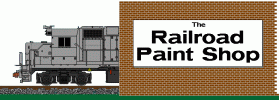
Designing Realistic Model Railroad Paint Schemes
Having difficulty sending e-mail to the site?
Information about EMD paint scheme elements adapted with permission from "The Men Who Styled the Streamliners," Parts 1 and 2, by Jim Boyd, November, 1984 and January, 1985 Railfan & Railroad. Information about ALCo paint scheme elements based on contributions by David Thompson and photographs in The Illustrated Treasury of the American Locomotive Company by O. M. Kerr.
In order to design a realistic paint scheme for a model railroad, it helps to have an idea of what goes into a realistic design. The easiest way to do this is to look at some of the "classic" paint scheme designs used by the prototype.
Most prototype designs can be described as a "layer cake" made up of 2-3 primary colors, with or without an accent color. Schemes designed for cab units tend to have a fairly detailed nose pattern, flowing back into simple side patterns that follow the lines of the locomotive carbody, using radiator grills, the roofline, and side panels as color separation lines and/or pinstripes. Schemes designed for switchers or hood units tend to be somewhat plainer, with natural lines such as radiators, battery boxes and frames typically being used as color separation lines and/or pinstripes. Overall schemes tend to be made up of combinations selected from several "standard" elements. Several of these elements will be described and illustrated below. Most of the examples used on this page are based on designs created by EMD, with a few from ALCo as well. They do not cover all designs used by any locomotive builder. The examples given are intended to serve only as guides and suggestions for ideas, not as a comprehensive catalog of railroad paint designs. In addition, these elements apply mainly to paint schemes designs fron the late 1930's through the early 1960's. Radically different paint schemes such as the McGinnis designs used by the New Haven and Boston & Maine, or New Jersey Transit's "Disco Stripes," have little in common with the classic paint schemes used earlier. In addition, the late 1960's and early 1970's saw the introduction of single-color "dip jobs," such as those used by Penn Central, Conrail, or Norfolk Southern, as a cost-saving measure, replacing many of the earlier multi-colored, patterned schemes. Today, fancier schemes seem to be making a comeback, as railroads once again realize the public relations value of a good-looking locomotive.
When designing your model railroad's paint scheme, keep in mind your railroad's era and history - if you're modeling a 1950's-era line, you probably want a somewhat fancier scheme than if you're modeling the 1970's or 1980's. If your line has been around for a while, you might want to develop a "historical record" of paint schemes - many railroads that started with cab unit schemes later adapted them to hood units, and then simplified the schemes to reduce the cost and time spent painting the locomotive. You may want to consider designing a similar progression. While it may take some time, the end result will probably be much more realistic and interesting than if you started with designing a hood unit scheme from scratch. It also may provide the opportunity to have some "older" equipment on the layout, still in a faded version of an "original" paint scheme.
To assist you in creating a design using the sample elements on this page, each thumbnail example is linked to a larger version. All examples for the same type of locomotive (cab unit, hood unit, switcher) contain one element on the same sized background drawing. You can overlay the drawings using a paint program (such as MS-Paintbrush), changing the colors as needed to build up a sample scheme for your railroad. Feel free to change the shapes of the colored areas as you see fit - these sample elements are not intended as a definitive catalog of all possible paint schemes, but merely as a sampling of possibilities to give you some ideas.
Cab Unit Paint Scheme Elements:
- Pinstripes
- Lines along grill
- Loops
- Paint Color Separation Lines (used both with and without pinstriping)
- Radiator Grill
- Roofline
- Lower Side Panel
- Nose/Headlight Mask
- Nose "Bib"
Switcher/Hood Unit Paint Scheme Elements (for those not based on cab unit schemes):
- Pinstripes
- Radiator - Examples of use: IC, Santa Fe, KCS, B&O, C&EI, Appalacicola Northern


- Frame - Examples of use: SP switchers, IC, Santa Fe, KCS, B&O


- Upper hood edge (used by ALCo) - Examples of use: Alaska RR, Bingham & Garfield


- Frame and battery box edges (used by ALCo) - Examples of use: Bingham & Garfield, Youngstown & Northern


- Cab side (used by ALCo) - Examples of use: Delaware & Hudson, Canadian Pacific


- Radiator - Examples of use: IC, Santa Fe, KCS, B&O, C&EI, Appalacicola Northern
- Paint Color Separation Lines (used both with and without pinstriping)
- Radiator - Examples of use: BN, Frisco, EMD GP35 Demonstrator, Colorado & Wyoming, UP

- Battery box - Examples of use: Frisco, EMD GP35 Demonstrator, Colorado & Wyoming, Northwestern Steel and Wire


- Cab windows - Examples of use: Northwestern Steel and Wire

- Hood ends - Examples of use: Santa Fe, EL

- Side loops(used by ALCo) - Examples of use: NdeM, St. Mary's RR



- Radiator - Examples of use: BN, Frisco, EMD GP35 Demonstrator, Colorado & Wyoming, UP


















